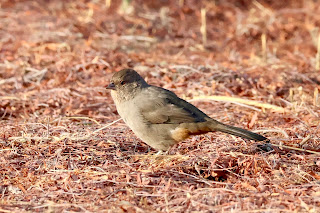In Southern California for the past six days with temperatures as high as 105-107F each day I went birding. Blazing sun overhead, it was a challenge. Nevertheless, I managed some interesting sightings.
Tyrannus sp., probably Cassin's (Tyrannus vociferans). I have a variety of poor photos like the one above. Cassin's is the only kingbird that is present in S. California year around. Two or three pairs were near my accommodations, but I could never get a decent photo and I never really heard it vocalize.
Above and below: Cooper's hawk (Accipiter cooperii).
I believe the bird above is an adult female Black-chinned Hummingbird (Archilochus alexandri). I never got a better look at the bird and I'm not great at hummingbirds, but it's the only ID that makes sense to me.
Above and below: Oak Titmouse (Baeolophus inornatus).
House Finch (Haemorhous mexicanus). I saw a lot of House Finches and was reminded that House Finch was once an exclusively western bird.
The bird above surprised me. It reminded me of the poor lighting I was constantly photographing in. No matter the time of day, or direction, the sun was so harsh. Looking through binoculars or the camera viewfinder revealed a bird but none of the identifying field marks. When I downloaded my photos on the computer this bird was not the House Finch I thought it to be. I believe this bird is a female Lazuli Bunting (Passerina amoena).
Perhaps one of my worst photos of the trip, but Black Phoebe (Sayornis nigricans) is always identifiable.
Above and below: Another Tyrannus sp.
The mighty Pacific Ocean taken from a trail lookout at Torrey Pines State Park near La Jolla.
Above and two below: California Towhee (Melozone crissalis). California Quail (Callipepla californica) is the State bird of California, which I also saw, albeit poorly, at Skinner Reservoir. The State bird, plain as it is, could just as easily be California Towhee, which I saw every day.
Above and below: Snowy Egret (Egret thula), which at first, in the harsh glare of the sun, I thought was a Great Egret (Albea alba). In the photo above it reveals its yellow slipper. I was accompanied by a non-birder who waded into the water after the bird (yes, this is true) and, of course, it flushed fully revealing its yellow feet.
Western Gull (Larus occidentalis). A large, elegant and beautiful gull. Should probably get its own post.
Western Gull
Western Gull
Western Gull
Western Grebe at Skinner Reservoir will get its own post later.
Marbled Godwit (Mimosa fedoa). This bird will get its own post later.
Above and below: Greater Yellowlegs at Skinner Reservoir.
Above and below: Pied-billed Grebe at Skinner Reservoir
Song Sparrow (Melospiza melodia) at Skinner Reservoir, the only sparrow I saw the whole trip.
Above and below: Raggedy Northern Mockingbird (Minus polyglottus), beak open to dissipate heat. I saw many birds, not only passerines, keeping their beak open.







































No comments:
Post a Comment